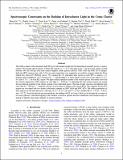Spectroscopic constraints on the buildup of intracluster light in the Coma Cluster
Abstract
The stellar content of the intracluster light (ICL) provides unique insight into the hierarchical assembly process of galaxy clusters. We present optical spectra of three ICL regions (μ g ≈ 25.3-26.2 mag arcsec-2) in the Coma cluster, located between 100 and 180 kpc from their nearest brightest cluster galaxies (BCGs): NGC 4889 and NGC 4874. Integral-field unit (IFU) spectroscopy with 13.5 hr on-source integration was acquired in an ancillary program within the Sloan Digital Sky Survey-IV MaNGA survey. We stacked the 127 individual fiber spectra in each IFU to achieve a 1σ limiting surface brightness of 27.9 mag arcsec-2, corresponding to a mean signal-to-noise ratio in the optical of 21.7, 9.0, and 11.7 Å-1, for each ICL region. We apply stellar population models to the stacked spectra. Our results show that the velocity dispersions of ICL regions are very high (σ ∼ 630 km s-1), indicating the stars in these regions are tracing the gravitational potential of the cluster, instead of any individual galaxy. The line-of-sight velocities are different from each other by ∼700 km s-1, while the velocity of each region is similar to the closest BCG. This suggests that the ICL regions are associated with two distinct subclusters centered on NGC 4889 and NGC 4874. The stellar populations of these regions are old and metal-poor, with ages of {equation presented}. From the derived age and metallicity, the buildup of ICL in Coma is likely to be through the accretion of low-mass galaxies or the tidal stripping of the outskirts of massive galaxies that have ended their star formation early on, instead of directly from major mergers of massive galaxies.
Citation
Gu , M , Conroy , C , Law , D , Van Dokkum , P , Yan , R , Wake , D , Bundy , K , Villaume , A , Abraham , R , Merritt , A , Zhang , J , Bershady , M , Bizyaev , D , Drory , N , Pan , K , Thomas , D & Weijmans , A M 2020 , ' Spectroscopic constraints on the buildup of intracluster light in the Coma Cluster ' , Astrophysical Journal , vol. 894 , no. 1 , 32 . https://doi.org/10.3847/1538-4357/ab845c
Publication
Astrophysical Journal
Status
Peer reviewed
ISSN
0004-637XType
Journal article
Description
M.G. acknowledges support from the National Science Foundation Graduate Research Fellowship and the Henry Norris Russell Postdoctoral Fellowship. C.C. acknowledges support from NASA grant NNX15AK14G, NSF grant AST-1313280, and the Packard Foundation. M.A.B. acknowledges NSF Award AST-1517006. The computations in this paper were run on the Odyssey cluster supported by the FAS Division of Science, Research Computing Group at Harvard University. Funding for the Sloan Digital Sky Survey IV has been provided by the Alfred P. Sloan Foundation, the U.S. Department of Energy Office of Science, and the Participating Institutions. SDSS-IV acknowledges support and resources from the Center for High-Performance Computing at the University of Utah.Collections
Items in the St Andrews Research Repository are protected by copyright, with all rights reserved, unless otherwise indicated.

